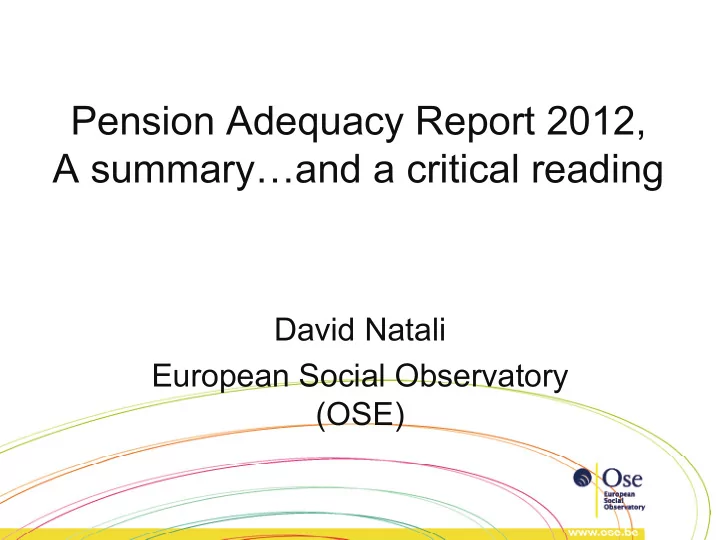

Pension Adequacy Report 2012, A summary…and a critical reading David Natali European Social Observatory (OSE)
The Pension Adequacy Report, a Summary •Definition of adequacy and its challenges •Current adequacy •Future adequacy •Knowledge gaps
1. The context, the state of pensions in Europe • Public pension expenditures make up a big part of public expenditure (EU-27: 11.3% of GDP in 2010 , variance 6% - 15%) • Over 120 million or around 24% of Europeans are pensioners. Almost 2/3 of these are women. • The EU-27 at-risk of-poverty-rate for people 65+ is 15.9% (below the 16.5% for people below 65) • In economic crisis the incomes of older people have been relatively better protected than those of the working age population
1. The context, demographic trends • old-age dependency ratio (persons aged 65+ as % of the number of persons aged between 20 and 64); • economic dependency ratio (inactive population 65+ as % of employed 20-64), •Doadr, from 28.4% in 2010 to 57.7% in 2060 •Eoadr, from 39.8% in 2010 to 73% in 2060 • key issue: to address ageing it is crucial to increase employment at all ages
2. Pensions Adequacy and its challenges •Adequacy • poverty protection • income replacement • pensions also need to be sustainable, safe and adapted to changing circumstances (adequacy, sustainability and modernisation) •Main challenges • Demographic trends • Recent economic trends • Recent reforms and the trade-off between sustainability and adequacy
3. Current adequacy • Pensions and income replacement • TRR, 53% in 2010 in EU-27(decline between 2005 and 2007; increase between 2007 and 2010) • female pensioners suffer lower protection compared to men • earnings-profile (for workers with low earnings, statutory public schemes tend to have a more significant role) • affects of work longer and career breaks • role of supplementary schemes
3. Current adequacy • Pensions and poverty prevention • The EU-27 at-risk of-poverty-rate for people 65+ (15.9%) is below the rate for those below age 65 (16.5%) and are less affected by material deprivation than the rest of the population (8.5%). Inequality among people 65+ is also lower • At-risk-of poverty-rates and severe material deprivation of people aged 65+ on a downward trend in many Member States • In the economic crisis older people have been relatively better protected
3. Current adequacy • Pensions and poverty prevention • single women more at risk • older pensioners more at risk positive trends (but problems related to • economic crisis) • income distribution is more equal
4. Future adequacy • Pensions and income replacement • lower future replacement rates for a given retirement age • net replacement rates can decrease by at least 5 percentage points (p.p.) in 17 Member States between 2010 and 2050 •Reinforcement of the link between contributions and benefits may translate into relatively larger declines of replacement rates for low income earners and increased inequality in old age
4. Future adequacy • Pensions and income replacement • decreasing replacement rates have to be seen in the context of the transition to multi-tier pension arrangements. • While in some countries replacement rates will be dropping, care-crediting will improve and crediting for up till three years of unemployment will be similar to what it is today.
4. Future adequacy • Pensions and income replacement • people will have to work longer and/or take advantage of improved opportunities to build supplementary entitlements • delaying retirement by two years (retirement in 2052 at 67 after a 42-year career) will result in higher future net replacement rates • Longer working (and reducing early retirement) is thus one option, but the challenge is to a large extent with the labour market to provide enough job opportunities for the older workers
4. Future adequacy • Pensions and poverty prevention • Increasing the relative equivalised income of older people who are at-risk-of-poverty by 20% could help to lift around 7 million persons • A relative drop in incomes of elderly people by 1/7th could add another 8.7 million people to the group at-risk-of-poverty
The Pension Adequacy Report, a critical reading Pros •A more holistic approach; •More articulated understanding of ageing (old age vs economic dependency ratio) •The focus shifts towards activation (rather than cuts) • All age groups/main focus on effective retirement age •Stress on inequalities (gender dimension) • Problems of career breaks
The Pension Adequacy Report, a critical reading Cons •Limited focus on taxation (revenue side); •Inequalities have to be better addressed (e.g. type of contracts: typical/atypical) ; •Limited reference to the need for flexibility; •‘Rosy’ picture of the crisis and its impact on pensions
The Pension Adequacy Report, a critical reading Cons •Future adequacy (only income replacement); •Still partial review of the pension mix (few information on pension funds); •Limited reference to regulation of pension funds (investment risks)
Points to Be Debated •The right mix between pension and labour market policies needs to look at job quantity and quality •Referring to pension funds as the solution to adequacy problems is risky •Still limited understanding of inequalities • In some countries the coverage of specific groups is limited (SME; services sector; atypical workers; migrants)
Recommend
More recommend